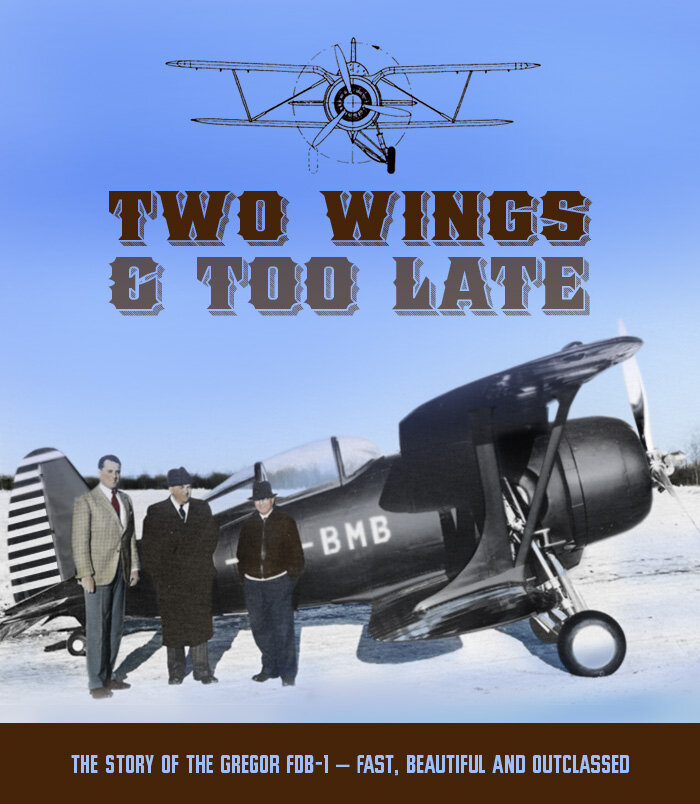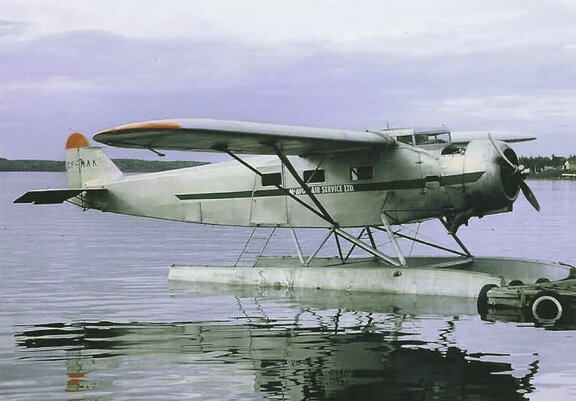QUEEN OF THE HURRICANES — The Elsie MacGill Story
The word “unique” seems inadequate and an understatement when attached to the remarkable life of Elizabeth Muriel “Elsie” Gregory MacGill.
A Canadian born in Vancouver in 1905, Elsie MacGill grew up to become the first woman aeronautical engineer and professional aircraft designer in the world. She helped develop many of Canada’s most innovative bush planes and many aircraft components in her early career and was responsible for the design of a military trainer in it is entirety: another first.
Her amazing life was dotted with many other “firsts” and situations in which she would be identified as “the only one”. Elsie was the first and lone woman in engineering classes at four different universities. She was the first woman electrical engineer in Canada upon her graduation from the University of Toronto in 1927, and two years later at the University of Michigan, she became the first woman to earn a Master’s degree in aeronautical engineering anywhere. Within a decade, Elsie would be the first woman admitted to the Engineering Institute of Canada and, in the years that followed, many other professional organizations in Canada and abroad accepted her as their first woman member and honoree.
In her later life, MacGill picked up the social justice baton that her mother, the pioneering suffragette and judge Helen MacGill, had carried decades earlier and assumed a leadership role in the Canadian women’s movement, which culminated in appointment to the landmark Royal Commission on the Status of Women in the late 1960s. While working as a member of the Commission and as the driving force for the adoption of its recommendations, Elsie MacGill established herself as “one of the most important individual women” of her time, a woman who is said to have “entirely change[d] the nature of [a] country, legally, economically, and certainly in terms of the quality of life”.
A new account of her life story has been branded “fascinating and inspiring” not only because of her professional life, but also because of her personal circumstances and the context of her achievements, which included a serious physical disability. On the eve of her graduation from Michigan in Ann Arbor, she fell ill with a flu-like virus waking up the next morning completely paralyzed from the waist down. After spending much of the next three years bed-ridden or in a wheelchair with the prognosis of “will not walk again,” Elsie fought her way back, regained strength and developed an ability to move upright with the help of canes. While she rarely referenced her disability as anything more than an inconvenience, others saw it as dreadful and devastating.
Elsie MacGill’s story is one of courage and determination that all Canadians can celebrate, but it is particularly intriguing for those interested in Canada’s aviation heritage as her life is intertwined with many of the great milestone events in the development of the Canadian aircraft industry.
After spending two years in graduate studies with venerated aeronautical engineers at M.I.T., Elsie returned to Canada in 1934 to work as an Assistant Engineer at the new Fairchild Aircraft plant in Longueuil, Quebec arriving in time to contribute to the refinement and further development of the Fairchild Super 71, a streamlined and innovative monocoque monoplane and the first aircraft with an all metal fuselage to be both designed and built in Canada. The Super 71 and its successor the Super 71P (redesigned for RCAF photographic survey work) were, like many of Elsie’s other Fairchild projects, challenging and exciting learning experiences for Elsie and her colleagues that highlighted the era of growth and innovation in the industry.
The prototype Fairchild Super 71, the first aircraft with an all-metal fuselage to be both designed and built in Canada. Built in Quebec, it made its first flight October 31, 1934. This particular aircraft struck a log and sank October 3, 1940. In 1978 it was retrieved by Western Canada Aviation Museum and restoration began in 1987. Powered by a 9 cylinder Pratt & Whitney Wasp engine. Photo: The Fairchild Corporation via www.1000aircraftphotos.com
The Fairchild Super 71P in Royal Canadian Air Force markings. This aircraft served at Rockcliffe, Borden and then Trenton.
Related Stories
Click on image
Before leaving the firm in May 1938, Elsie also designed wings and other components as well as contributing to the development of the highly popular Fairchild 82 bushplane series and taking a more senior role in the design and refinement of the less popular and problematic 45-80 Sekani. Elsie’s disability had forced her to shelve her ambition to be a pilot, but she always insisted, whenever possible, on riding along as the official observer in all test flights. While at Fairchild, she also began establishing her skill and reputation as an expert in stress analysis, thus laying the foundation for her seminal role in the establishment of the International Civil Aviation Organization (ICAO) in the post-War period when she served as a Technical Advisor and Chair of one to the ICAO’s inaugural technical committees that laid the foundation for innovation, aircraft design, and safety regulations around the world.
First, however, there was a war to win.
This photograph of McAvoy Air Services’ 1938 Fairchild model 82D (CF-MAK) was taken on July 12, 1962, while moored at the Float Base tie-up in the Old Town at Yellowknife, Northwest Territories. Photo: The Fairchild Corporation via www.1000aircraftphotos.com
The beautiful if entirely ineffectual Fairchild Sekani was named after a West Coast tribe whose name means “dwellers on the rocks” - a harbinger of the project’s inability to get off the ground. The Sekani’s lines may have been promising, but it was underpowered and difficult to control. Even MacGill was guilty of a little style over substance. Only two were built. Inset: Despite its somewhat less than stellar performance, it was selected as one of 25 bushplanes featured in Jello’s Airplane Coin series of collector medallions from the 1960s. Photo: The Fairchild Corporation via www.1000aircraftphotos.com
Elsie left Fairchild to accept the position of Chief Aeronautical Engineer at the growing Canadian Car and Foundry aircraft plant in Fort William (now Thunder Bay) at the far and frosty end of Lake Superior. Can-Car was involved in a few innovative, some might say bizarre, aircraft manufacturing ventures at the time, and the environment at the firm fluctuated between tension and excitement as the company sought to expand its capacity in anticipation of the demands of another overseas war.
During her first year as head of engineering at Can-Car, Elsie helped the firm’s FBD-1, a sleek biplane and Canada’s first all-metal fighter, achieve its airworthiness certification, and she helped in the testing and engineering for some of the controversial G-23 Goblin fighters the company built under a license arrangement with Grumman. Her most memorable early experience at Can-Car was the assignment to design and construct a biplane trainer for the Mexican Air Force dubbed the Maple Leaf II (to distinguish it from the prior failed Maple Leaf I attempt at a trainer design). Elsie’s aircraft, which was eventually produced in a small quantity (10 others) in Mexico, was likely the first aircraft fully designed and produced under the supervision of a woman adding to her credentials as a unique element of the history of aviation.
As exciting and personally fulfilling as the Maple Leaf trainer project was for Elsie, her aviation career was defined to a much greater degree by the next project that came through her office door. With the outbreak of World War II, Can-Car, with high level political support that included that of Lord Beaverbrook and C.D. Howe, was charged with mass production of Hawker Hurricanes in its isolated and protected production centre that could support the endangered and strained aircraft manufacturing facilities in Britain. Gearing up for Hurricane production was an enormous logistical task for the fledgling Northern Ontario aircraft maker, and Elsie MacGill was at the centre of the whirlwind of technical documents, design changes, and personnel issues that included the training and management of thousands of workers, many of whom were young women adapting, like Elsie, to non-traditional roles far from home. Can-Car produced 1,451 Hurricanes before the War’s end including a number that arrived in time to play a symbolic role with the RCAF in the Battle of Britain. Elsie MacGill is formally credited with designing the ski and de-icing equipped “winterized version of the Hurricane”: two of which were built and tested by Can-Car and the government in 1943. Her exploits were even celebrated in media reports and even in an issue of the U.S. True Comics series as those of “the Queen of the Hurricanes”.
The success of the Hurricane project earned Can-Car respect and brought it a contract for the manufacture of 1,000 Curtiss-Wright Helldiver bombers for the U.S. Navy. Elsie was once again in the vortex of a firestorm of frustrating engineering and design changes. This time the experience was less rewarding as it ended for Elsie with her dismissal intertwined with her relationship with plant manager Bill Soulsby, a widower and father of two who was also fired the same day. Elsie and Bill were married two weeks later in June 1943. They moved to Toronto where Bill resumed his career as an aircraft manager first with Victory Aircraft and later with Avro and Orenda. Elsie established a consulting business in aeronautical engineering, another first, and worked for TCA, de Havilland, and other firms as well as the ICAO and the National Research Council from this base.
A fall in 1953 put Elsie back in hospital, bed and a wheelchair prompting her to reflect and to write My Mother the Judge, the biography of her then late mother Helen. The experience of writing the book was a platform for change and the final phase of Elsie’s life which included a term as National President of the Canadian Federation of Business and Professional Women’s Clubs and then her acclaimed role on the Royal Commission for the Status of Women.
Throughout her career, Elsie MacGill received many honours and awards: the Gzowski Medal of the Engineering Institute of Canada (1941); the American Society of Women Engineers (first non-American to be named) "Woman Engineer of the Year" (1953); the Order of Canada (1971); the Gold Medal of the Association of Professional Engineers of Ontario (1979), and many others. But she treasured most the Amelia Earhart Medal she received from the International Association of Women Pilots in 1975 for her years as an observer on test flights and her work in defining standards for test flight records. She died of pulmonary fibrosis in 1980 while visiting her sister near Boston. Posthumously, Elsie, who is said to have “paved the way for a generation of young women, inspiring them and showing by example that any goal in life is attainable through hard work and determination,” was inducted into Canada's Aviation Hall of Fame in the 1980s and into the Canadian Science and Engineering Hall of Fame in the 1990s.
Vintage Wings is helping to celebrate the life of Elsie MacGill with its support of the first full biography about her. Entitled “Her Daughter the Engineer”, the book was officially launched at the Vintage Wings Open Hangar Day on June 7th, 2008.
It is available through the Ottawa publisher NRC Research Press.
























